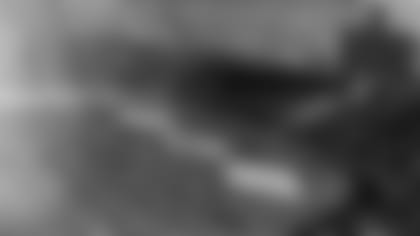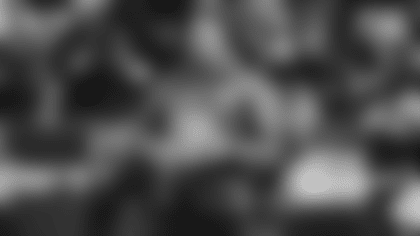Christopher from Green Bay, WI
The DVD "The Legend of Lambeau Field" shows the stadium before the Ice Bowl with wooden bleachers. My grandfather was at the Ice Bowl and he confirmed to me before he died that there were wooden bleachers. Why does the official Packers' website state the wooden bleachers were removed after the inaugural 1957 season?
Chris, join the crowd. Several people have asked that question and your grandfather was right. What is now Lambeau Field – named City Stadium from 1957-65 – had wooden bleachers for the first 12 seasons of its existence. That means they were there when the Ice Bowl was played Dec. 31, 1967. The wooden bleachers were removed and replaced with aluminum bleachers prior to the 1969 season. The aluminum bleachers were fastened to the same brackets that held the wooden bleachers. At the time, Lambeau had a capacity of 50,861. In the Lambeau Field section of the Packers Media Guide, it incorrectly states that the wooden seats installed in 1957 were removed after just one season. I'm not certain where that came from. The cost of replacing the wooden bleachers was roughly $350,000. That was nearly a third of what it cost to build the stadium. So it would have made no sense to rip out the wooden bleachers after one year. We'll get the media guide corrected before next season and get things right in the future.
Robert from Milwaukee, WI
I was doing some research on the history of the Lambeau Leap and wondered, since LeRoy Butler did it, how many people and how many times have players made the Leap?
Thanks to Tom Fanning, our communications manager and numbers guru in the PR Dept., I can tell you that since Butler soared into the south end zone at Lambeau Field on Dec. 26, 1993, the Packers have scored 549 touchdowns in regular-season games there and 586, if home playoff games were included. Then there'd be another batch of preseason TDs. But there's no way of coming up with an official count or a complete list of players who have taken flight into the lower rows of Lambeau. No. 1, I don't remember Butler's leap triggering the tradition. I think it gradually took off after Robert Brooks did it in 1995. Also, not every player takes "The Leap."
Joe from Sherman, IL
I was watching some film on the '61 championship and Forrest Gregg started at right guard and Norm Masters at right tackle. What happened to Jerry Kramer that year?
Jerry Kramer injured his ankle on the opening kickoff of the seventh game of the season, underwent surgery and didn't play again that year. Backup center Ken Iman took over for Kramer in that first game, then tackle Norm Masters moved to right guard the next week. Finally – I believe before the Thanksgiving game in Detroit – Vince Lombardi decided to shift Gregg from right tackle to right guard and play Masters at right tackle. In fact, I had a chance to talk to Forrest before Sunday's game against Detroit, and he speculated Lombardi probably made the switch because of Alex Karras. Based on what I've heard from former staff members, Karras was near the top of the list of defensive players that caused Lombardi the most concern. Prior to Kramer's injury, Masters and Bob Skoronski split playing time at left tackle and there was little difference between the two. So the Packers still had five capable starters even without Kramer. It was just a matter of finding the best fit on the right side.
Jim from Westbrook, ME
I've been a Packers fan since the early 1960s. People are always asking me how I became a Packers fan and being only about 12 at the time, I have no special recollection. I had heard a rumor the Packers played an exhibition in Maine in 1959 and I was wondering if that were true and if there was any record of the game that could be read?
On Sept. 5, 1959, the Packers lost to the New York Giants, 14-0, in a preseason game at Bangor, Maine. It was the Packers' fourth preseason game in Vince Lombardi's first season as coach and Lamar McHan made his first start at quarterback. Bart Starr, Babe Parilli and Joe Francis started the first three games in that order. McHan completed only five of 14 passes for 65 yards against the Giants, but would beat out the others and start the season opener. McHan played most of the game in Bangor, but Parilli appeared briefly at the end of the first half and Francis took over for the final drive. The game was played at Garland Field -- later renamed Cameron Stadium -- and the Packers stayed at the Bangor House the two nights they were there. I would check to see what libraries in Maine have the Bangor paper on microfilm and look for it there. Otherwise, you'd probably find at least a short game story in The New York Times.
Jim from Woodbury, MN
I was wondering if you could tell me when was the last time the Packers beat an AFC opponent on the road in December? I know it's not an opportunity they have every year, but it seems like it's been a while.
Dec. 22, 2003, the night after Brett Favre's father died, and he shelled the Oakland Raiders for four touchdown passes. Since then the Packers have lost to Baltimore (2005), Jacksonville (2008), Pittsburgh (2009), New England (2010), Kansas City (2011) and Buffalo this season.
Tom from Chesterfield, VA
You said in a recent column that ''I can't remember the Packers scoring on a sweep in a championship game." What about Jim Taylor's 14-yard run for the first score vs. the Chiefs in the initial Super Bowl? Wasn't that a sweep?
Taylor scored the second touchdown in Super Bowl I and, yes, it was on a sweep, but it wasn't Lombardi's signature play. I omitted an important modifier in the sentence you referenced in my Oct. 15 Cliff's Notes. I should have put the word "power" before the word "sweep." I thought it was implied, but when I reread it, it was my error. Taylor scored on a weak-side sweep. Here's the difference. In the power sweep, the halfback carried the ball and ran to the strong side of the formation. The strong side was the side where the tight end and flanker lined up, which back then was almost always the right side. Elijah Pitts started at halfback in Super Bowl I. But when Paul Hornung and Taylor were running in tandem, the only time Hornung didn't carry on the power sweep was on those rare occasions when those two flip-flopped positions. Both the power and weak-side sweeps were run from a split-back formation with the halfback on the weak side and the fullback to the strong side. But the weak-side sweep was a different call with a different blocking scheme. The weak-side sweep was one of the plays the Packers used to fool a defense when it was overplaying the power sweep. The halfback option and Lombardi's sucker-trap were two others. But those three plays were not bread-and-butter plays in Lombardi's playbook. In Super Bowl I, Taylor ran around left end or to the side opposite the tight end and flanker. The weak-side sweep called for the split end to line up tighter to the line than normal and become a lead blocker. Thus, on Taylor's TD, Max McGee threw the key block at the point of attack. Anyway, I give you credit for recognizing that it was a sweep of some form. People commonly refer to Hornung's 13-yard TD run around left end against Cleveland in the 1965 championship game as a sweep. It wasn't. Backup quarterback Zeke Bratkowski told me it was a made-up play with no real name used for that particular situation. The formation and blocking scheme were different from the sweep.
Tom from Nipomo, CA
I read your article about the confusion between 1919 and 1921. I am confused about 1923. I recently bought another shareholder's hat, and noticed the other day for the first time that it says "Established 1923" on it. Now that I can understand what happened in 1919 and 1921, what happened in 1923 that results in that date being included on the shareholder hats?
Be assured your shareholder hat is correctly embroidered or marked. The Green Bay Football Corporation was created in August 1923. That's when the Packers became publicly owned following a financially disastrous 1922 season. Essentially, 1923 was the start of fan ownership, although that corporation went into receivership in the mid-1930s and was replaced by Green Bay Packers Inc., which is still an active corporation today. In 1922, the Packers were owned by the Green Bay Football Club, a private corporation with Curly Lambeau as president and Joe Ordens, Nathan Abrams and George Whitney Calhoun as the other officers.
James from Beaver Dam, WI
Is there a video on the history of the Packers?
Yes, "The Grandstand Franchise," a one-hour documentary produced by the University of Wisconsin-Green Bay in the 1980s. It was narrated by Ray Scott and well done.
Joe from Park Falls, WI
I have been researching and have come up short. Who scored the first Packers' touchdown?
Quarterback Dutch Dwyer on a straight-line plunge through center in the first quarter of the Packers' first game played Sept. 14, 1919, against a team officially listed as the Menominee North Ends. Art Schmaehl scored the first touchdown in the Packers' first game in what is now the National Football League. That game was played Oct. 23, 1921, against the Minneapolis Marines.
Bryan from Shanghai, China
People want to know why I follow the Packers. I refer to a game in the early '80s, when the Packers beat Washington, 48-47. I seem to remember that as the game expired, the Redskins missed what would have been a game-winning field goal. However, I am now a little hazy on the exact details. Can you help me out?
The game was played Oct. 17, 1983. The game was tied three times in the first half. In the second half, the lead changed hands six times. The final time was when Jan Stenerud kicked a 20-yard field goal with 54 seconds remaining, making it 48-47. With three seconds to go, Washington's Mark Moseley lined up for a 39-yard field goal. Moseley had kicked 12 game-winning field goals in his career. He also had made 20 of 21 field goal attempts the previous season when Washington won Super Bowl XVII. But he missed this one to the right. Actually, if you're looking for a first-hand account, submit a question to Mark Murphy, our president and CEO at MurphyTakes5@packers.com. He was one of Washington's starting safeties that night.















